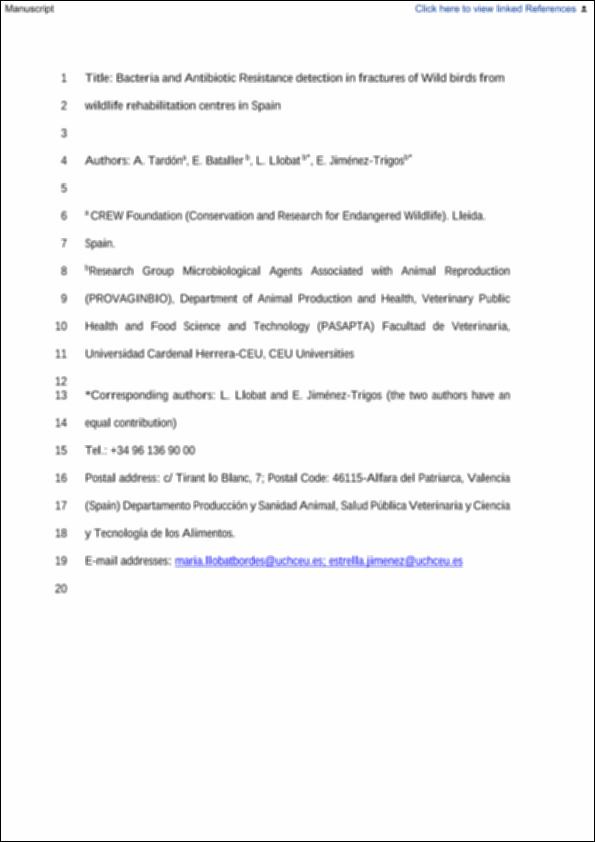Por favor, use este identificador para citar o enlazar este ítem:
http://hdl.handle.net/10637/13456Bacteria and antibiotic resistance detection in fractures of wild birds from wildlife rehabilitation centres in Spain
| Título : | Bacteria and antibiotic resistance detection in fractures of wild birds from wildlife rehabilitation centres in Spain |
| Autor : | Tardón Bermell, Ana Bataller Leiva, Esther Jiménez Trigos, María Estrella Llobat Bordes, Lola |
| Materias: | Especies protegidas.; Bacterias - Resistencia a los medicamentos.; Wildlife conservation.; Fractures.; Birds.; Aves.; Fracturas.; Drug resistance in microorganisms. |
| Editorial : | Elsevier |
| Citación : | Tardón, A., Bataller, E., Llobat, L. & Jiménez-Trigos, E. (2021). Bacteria and antibiotic resistance detection in fractures of wild birds from wildlife rehabilitation centres in Spain. Comparative immunology, microbiology and infectious diseases, vol. 74, art. 101575 (feb.). DOI: https://doi.org/10.1016/j.cimid.2020.101575 |
| Resumen : | Anatomic adaptations make birds more prone to open fractures with exposed bone parts losing vascularization. As a result of this exposure, fractures are colonized by different microorganisms, including different types of bacteria, both aerobic and anaerobic, causing osteomyelitis in many cases. For this reason, antibiotic treatment is common. However, carrying out antibiotic treatment without carrying out a previous antibiogram may contribute to increased resistance against antibiotics, especially in migratory wild birds. In this paper, bacterial counts regarding fracture type, bacterial identification and antibiotic resistance have been analyzed in wild birds from wildlife rehabilitation centres in Spain. The results obtained showed that open fractures had higher bacterial counts (CFU/mL) than closed ones. Bacteria in family Enterobacteriaceae, identified were Escherichia spp., Enterobacter spp., Shigella spp., Hafnia alvei, Proteus mirabilis, Leclercia adecarboxylata and Pantoea agglomerans. Other bacteria present in wild birds’ fractures were Aeromonas spp., Enterococcus spp. Bacillus wiedmannii and Staphylococcus sciuri. All species found presented resistance to at least one of the antibiotics used. Wild birds can be implicated in the introduction, maintenance and global spreading of antibiotic resistant bacteria and represent an emerging public health concern. Results obtained in this paper support the idea that it is necessary to take this fact into account before antibiotic administration to wild animals, since it could increase the number of bacteria resistant to antibiotics. |
| Descripción : | Este artículo se encuentra disponible en la siguiente URL: https://www.sciencedirect.com/science/article/abs/pii/S0147957120301648?via%3Dihub This is the pre-peer reviewed version of the following article: Tardón, A., Bataller, E., Llobat, L., & Jiménez-Trigos, E. (2021). Bacteria and antibiotic resistance detection in fractures of wild birds from wildlife rehabilitation centres in Spain. Comparative immunology, microbiology and infectious diseases, vol. 74 (feb.), art. 101575, which has been published in final form at https://doi.org/10.1016/j.cimid.2020.101575 Este es el pre-print del siguiente artículo: Tardón, A., Bataller, E., Llobat, L., & Jiménez-Trigos, E. (2021). Bacteria and antibiotic resistance detection in fractures of wild birds from wildlife rehabilitation centres in Spain. Comparative immunology, microbiology and infectious diseases, vol. 74 (feb.), art. 101575, que se ha publicado de forma definitiva en https://doi.org/10.1016/j.cimid.2020.101575 |
| URI : | http://hdl.handle.net/10637/13456 |
| Derechos: | http://creativecommons.org/licenses/by-nc-nd/4.0/deed.es |
| ISSN : | 0147-9571 |
| Fecha de publicación : | 5-feb-2021 |
| Centro : | Universidad Cardenal Herrera-CEU |
| Aparece en las colecciones: | Dpto. Producción y Sanidad Animal, Salud Pública Veterinaria y Ciencia y Tecnología de los Alimentos |
Los ítems de DSpace están protegidos por copyright, con todos los derechos reservados, a menos que se indique lo contrario.


